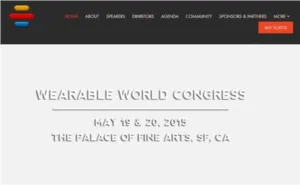The Wearable World Congress in San Francisco, organized by the Wearable World organization, addresses the development of all wearable technology and the Internet of Things. The conference was held at the Palace of Fine Arts in San Francisco, CA on May 19th and 20th, providing a platform for companies in the wearable and IoT space to connect and prosper. Wearable World acquired ReadWrite earlier this year that provided coverage and editorial support for the conference.
The Conference included a number of presentations as well as podium discussions. The main focus this year was on wearable devices including augmented and virtual reality devices, as well as smartwatches. There were also sessions covering sensors and applications that are not display-centric and which were mentioned only very briefly. Among those were Enviro Trackers, wearable cameras and other gadgets that are typically small and do not intrude on the appearance of the user.
This seems to be one of the key topics for wearable devices in general – make them unobtrusive and provide at least one function that the user may find useful. The lesson of the Google Glass release is still very new with all these entrepreneurs. Creating a device with no real value but a ton of features may not be successful in the consumer space.
Many speakers from the industry like Intel, HP, Under Armour and others met with CEOs and founders of start-ups that we have not heard of yet to paint the future success story of wearable devices. Who would have known that HP actually has a general manager for wearables and IOT, or that Capital One has a VP New Product Innovation? It shows that established companies are taking notice of this new space.
One session featured an on stage interview with Eric Migicovsky, CEO and Founder of Pebble. He sees the key to a successful future for wearable devices in open platforms, where apps are developed to run on a variety of OS platforms like Android and iOS. This is about the rivalry going on between iOS and Android about running apps on devices from competitors. From a total market perspective (the smartwatch market that is) this may be true, but this does not mean that everyone will play under this ideal.
Another topic was the discussion about women and wearables. Ayse Ildeniz, VP and GM for Business Development and Strategy, New Devices Group at Intel Corporation sees that most wearable devices were so far mainly developed for a technology-centric male audience (a nice reference to nerds I believe – NH). She sees that more emphasis on style will help to accelerate adoption. Style should be as important as any other functionality of any wearable device.
Marcus Weller, Chairman and CEO of Skully Helmets discussed the development a vertical product in the augmented reality space. We have reported on the Skully helmet before though.
The overall message seems to be that the wearable market is still searching for its place in the CE world. – NH

